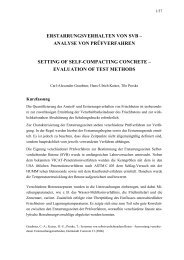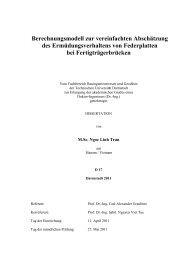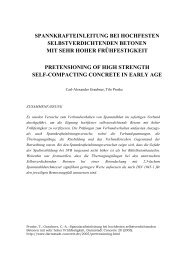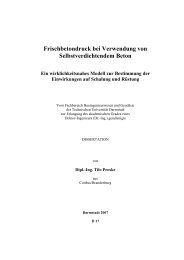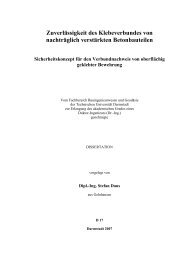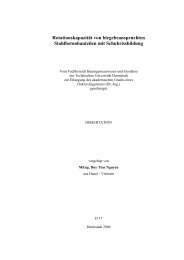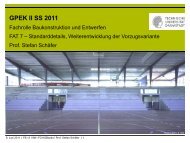GREEN CONCRETE - Institut für Massivbau
GREEN CONCRETE - Institut für Massivbau
GREEN CONCRETE - Institut für Massivbau
You also want an ePaper? Increase the reach of your titles
YUMPU automatically turns print PDFs into web optimized ePapers that Google loves.
<strong>GREEN</strong> <strong>CONCRETE</strong><br />
Tilo Proske, Carl-Alexander Graubner<br />
There is great potential for the reduction of the environmental impact and the consumption<br />
of scarce resources in the field of concrete construction especially in the production of raw<br />
materials, concrete technology and structures (see Fig. 1). Investigations on the topic of<br />
environmental optimisation of concrete are being carried out at the “<strong>Institut</strong> für <strong>Massivbau</strong>”<br />
in support of research activities in the field of Sustainable Concrete Structures.<br />
Fig. 1: Opportunities for ecological optimisation in concrete construction<br />
The major environmental impact of concrete comes from the CO 2 -emissions during cement<br />
production as a result of the calcination and grinding process including the deacidification<br />
of the calcium carbonate. Therefore reduction of the cement-clinker content has positive<br />
effects on the environmental life cycle assessment of the concrete and can be achieved by<br />
the optimisation of the mixture design (higher packing density, use of high reactive<br />
binder). Furthermore, substitution of the cement by secondary raw materials is an additional<br />
opportunity.<br />
1
For the practical application of green concretes, questions must be answered regarding the<br />
workability, the strength development and the durability. At the “<strong>Institut</strong> für <strong>Massivbau</strong>“ -<br />
different concretes with reduced cement content were developed. A compressive strength<br />
of 10 N/mm² at an age of 24 h and 35 N/mm² after 28 days was targeted. Starting with a<br />
cement content of 270 kg/m³ (type CEM I, minimum value according to DIN 1045-2:2001-<br />
07 for some exposure conditions), the cement content was reduced below 100 kg/m³. The<br />
powder content of approximately 400 kg/m³ was kept constant by the addition of fly ash<br />
und limestone powder.<br />
TC = 25°C<br />
Fig. 2: Compressive strength of cement reduced concretes<br />
It was noted, that even concretes with cement content lower than 150 kg/m³ were able to<br />
meet the defined strength requirements (see Fig. 2). However, a significant reduction in the<br />
water content, as well as addition of reactive powders like fly ash and silica fume or a<br />
higher cement strength class was necessary to achieve this. Additionally, a higher demand<br />
of superplasticizer was required. The optimisation of the clinker volume in the mixture<br />
composition has led to a reduction of 55 % in environmental impact compared with the<br />
standard concrete mixture. Further research work will include high performances binders<br />
and durability aspects.<br />
Keywords<br />
2<br />
Green Concrete, cement reduced concrete, fly ash, sustainability, environment, CO 2<br />
http://www.darmstadt-concrete.de/2008/greenconcrete.html



